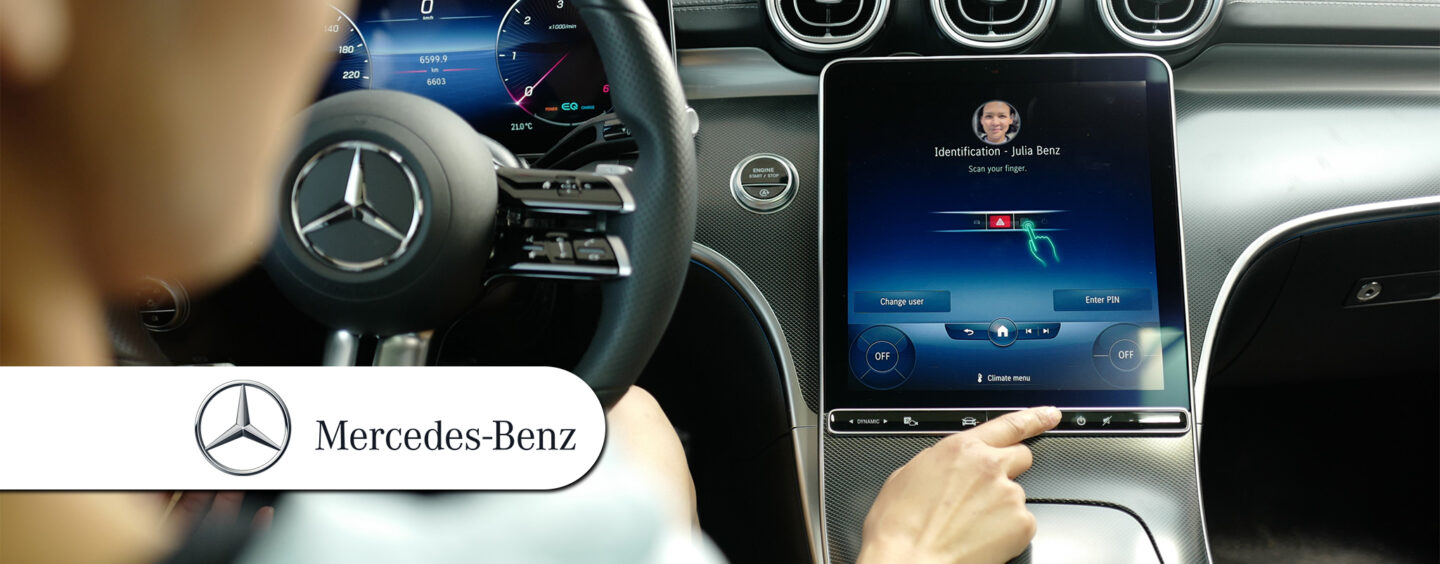
Mercedes Drivers Can Now Authenticate Payments With Fingerprint Sensor
by Fintechnews Switzerland March 13, 2023Since March, Mercedes-Benz customers in Germany are able to authenticate payments via an in-car fingerprint sensor. With the new digital payment service Mercedes pay+, Mercedes-Benz introduces native in-car payments.
With native in-car payments, the vehicle itself now enables biometric two-factor authentication in conjunction with the fingerprint sensor. It is no longer necessary to type in a PIN on the MBUX infotainment system or to use an additional mobile device such as a smartphone to verify a payment in the car. Instead, the car itself turns into a payment device.
The first Mercedes-Benz models available with fingerprint sensors are the EQS and EQE series, the Mercedes-Benz S-Class and C-Class, and the new GLC. Mercedes-Benz is the first car manufacturer worldwide to integrate Visa’s Delegated Authentication and Cloud Token Framework technology to enable native in-car payments. Visa Cloud Tokens provide an additional layer of security as they help to protect and encrypt sensitive payment information by converting data and storing it securely.
Upgrade of digital services and on-demand functions with one touch
Customers can use native in-car payment to pay for digital services that allow a more convenient and entertaining driving experience. They can activate and subscribe to these digital services from the car’s MBUX infotainment system and authorise the payment transaction with their fingerprint. Examples of these digital services are connectivity apps that control comfort functions of the car, such as pre-air conditioning of the vehicle via a mobile device. Upgrades to the vehicle software can easily be activated and paid for via fingerprint, like, for example, advanced navigation services that provide information on the weather or available parking spaces at customer’s destination.
In addition, the Mercedes me Store offers the ability to unlock pre-installed hardware components easily on-demand by fingerprint in the car. For example, a vehicle owner can subscribe to the Remote Parking Assist, a service to park the vehicle remotely with a smartphone, or activate and pay for the Adaptive Highbeam Assist or the Rear Axle Steering with larger steering angle with only one touch.
The portfolio of digital services and on-demand features in the Mercedes me Store is constantly expanding, offering customers the opportunity to personalise their vehicles further even after the purchase. This is of interest, for example, to the second or third owners of a vehicle as it gives them the opportunity to adapt pre-owned vehicles to personal needs and desires.
Cardholders with an eligible Visa credit or debit card can use native in-car payment by linking their card with their Mercedes me user account and activating Mercedes pay+ in the vehicle via MBUX. Subsequently, more card systems will be added and enabled for Mercedes pay+. Mercedes-Benz plans to launch Mercedes pay+ in other European markets in 2023.
Paying for car-related services will become even easier and more convenient
The option of native in-car payments will be expanded to other car-related services, such as fuelling. Mercedes-Benz drivers in Germany and other markets can already pay for fuelling directly from the car via the Mercedes me app and a smartphone or via the MBUX infotainment system using a PIN. The introduction of native in-car payments and the easy payment authorisation by fingerprint in the car will make this process more seamless and convenient later this year.
Mercedes-Benz already offers payment for charging of electric vehicles for years via the Mercedes me connect service Mercedes me Charge. At the charging station, authentication takes place via the display in the MBUX multimedia system, the Mercedes me App, the Mercedes me Charge card or directly via Plug & Charge.

Franz Reiner
“Mercedes-Benz becomes a software-driven company that provides a digital, seamless experience to customers. Therefore, our digital services have to be intuitive, convenient and secure. This is why we have established Mercedes pay+ as a modern and secure payment solution. As such, we are creating a completely new, enhanced customer experience. By introducing native e-commerce into the car, we are once again pioneers and at the beginning of a promising development.”
Franz Reiner, CEO at Mercedes-Benz Mobility
In future Mercedes-Benz Leasing Deutschland will enable money transfers in the Mercedes-Benz ecosystem for the German market as a licensed entity, including payments made in the car.
Global transaction volume for in-vehicle payments expected to exceed 4.7 billion by 2026
A study by Juniper Research revealed that the global transaction volume of in-vehicle payments will be expected to reach more than 4.7 billion by 2026. Paying for fuel will be the most common use for in-vehicle payments over the next five years; accounting for around 48 percent of total in-vehicle payment transactions by volume. This growth is regarded as the next step in a natural progress of payment methods regarding fuel purchases, which evolved from cash to card, then to smartphone payments, and now to in-car payments.
Customers consider increased convenience and ease in their daily life as the greatest advantage of in-car payments, as the current international market study “Global Trends in Automotive & Financial Services 2022“ shows. More than half of the potential users in Germany see in-car payment as a brand’s significant competitive advantage compared to other market participants.

Albrecht Kiel
“Innovating with partners, Visa can unlock the possibilities that connected devices might bring to commerce. Making your car a secure and fully authenticated payment device brings new ways to enhance journeys and looking ahead, we can imagine many moments where in-car payments could smoothen the driver experience. Visa brings its technology and expertise in Germany and worldwide to make payments reliable, secure and convenient as this and many other new ways to pay become a reality.”
Albrecht Kiel, Regional Managing Director, Central Europe, at Visa





